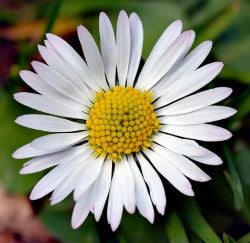Daisy
| Bellis perennis | ||||||||||||
|---|---|---|---|---|---|---|---|---|---|---|---|---|
 | ||||||||||||
| Scientific classification | ||||||||||||
| ||||||||||||
| Bellis perennis L. |
Bellis perennis is a common European species of Daisy, often considered the archetypal species of that name. Many related plants also share the name "Daisy", so to distinguish this species from other daisies it is sometimes qualified as Common Daisy, Lawn Daisy or occasionally English daisy. It is native to western, central and northern Europe. The species is widely naturalized in North America, where it is considered an invasive weed.
It is a herbaceous plant with short creeping rhizomes and small rounded or spoon-shaped evergreen leaves 2–5 cm long, grows close to ground. The flowerheads are 2–3 cm in diameter, with white ray florets (often tipped red) and yellow disc florets; they are produced on leafless stems 2–10 cm (rarely 15 cm) tall. The lawn daisy is a dicot.
Etymology
It is thought that the name "daisy" is a corruption of "day's eye", because the whole head closes at night and opens in the morning. Chaucer called it "eye of the day".
Daisy is also a common girl's name and is a nickname for girls named Margaret, which originally comes from the Latin word for daisy.
Uses
It is not affected by mowing and is therefore often considered a weed on lawns, though many also value the appearance of the flowers. Several cultivars and hybrids have been selected with much larger flower heads up to 5–6 cm diameter and with light pink to purple-red ray florets.
Bellis perennis has astringent properties and has been used in folk medicine.[1]
Green leaves are edible, consume moderately.
It has traditionally been used for making daisy chains as a children's game.[2]
Gallery
- Daisy's eye view.jpg
- Bellis perennis dsc00906.jpg
- Bellis perennis Marburg 01.jpg
- Daisy flower.jpg
- Field of daisies.jpg
- Sa Daisy flower.jpg
Daisy flower extreme close-up
- Daisy900ppx.jpg
ReferencesISBN links support NWE through referral fees
- ↑ Howard, Michael. Traditional Folk Remedies (Century, 1987), p129
- ↑ Children's 'right to play'. BBC News. BBC (2002-08-07). Retrieved 2008-11-02.
External links
- Bellis perennis (USDA plant profile)
Credits
New World Encyclopedia writers and editors rewrote and completed the Wikipedia article in accordance with New World Encyclopedia standards. This article abides by terms of the Creative Commons CC-by-sa 3.0 License (CC-by-sa), which may be used and disseminated with proper attribution. Credit is due under the terms of this license that can reference both the New World Encyclopedia contributors and the selfless volunteer contributors of the Wikimedia Foundation. To cite this article click here for a list of acceptable citing formats.The history of earlier contributions by wikipedians is accessible to researchers here:
The history of this article since it was imported to New World Encyclopedia:
Note: Some restrictions may apply to use of individual images which are separately licensed.

